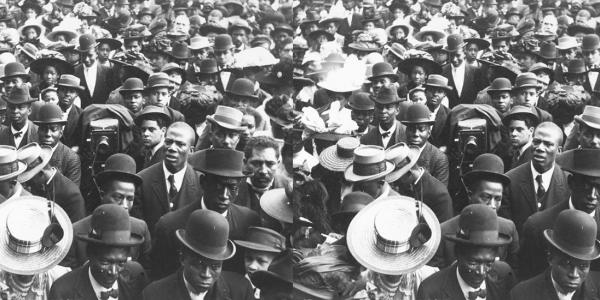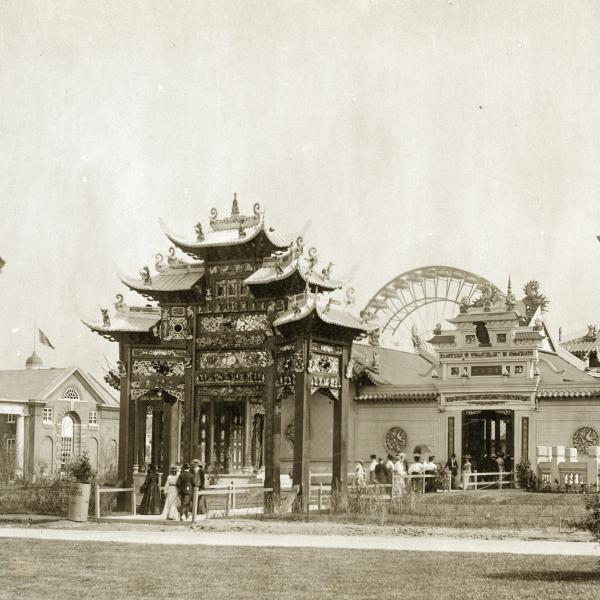Interview with Historian and Faculty Fellow Douglas Flowe
Historian Douglas Flowe doesn't study the heroes of history. Instead, his research is primarily concerned with themes of criminality, vice, leisure, and masculinity — and specifically how they converge with issues of race, class, and space in American cities. Flowe features these issues in his first book project, which he workshopped as a Faculty Fellow in the Center for the Humanities, “‘Tell the Whole White World’: Black Men and the Politics of Black Criminality in Early Twentieth Century New York City.”
Your book takes on the subject of black criminality, which has not been extensively covered. Why do you think that is?
Historians have avoided the subject of black criminality to a large extent after the 1965 report by Daniel Patrick Moynihan that assessed the “urban crisis” of that decade as the result of historical conditions and black pathologies that ultimately impacted black family, economic, and crime outcomes. Many scholars interpreted his report as essentially “blaming the victim” by foregrounding a “culture of poverty” among African Americans rather than structural issues of segregation, economic displacement, and urban redesign. In the decades after his report many liberal historians have attempted to refute this argument by focusing on black political, economic, and cultural self-determination and have specifically avoided crime. In the past twenty years a number of historians have changed this trend including Kali Gross (Colored Amazons, 2006) and Cheryl Hicks (Talk With You Like a Woman, 2010), both of whom have opened up the field for more analysis. I see my work as fitting in this recent historiography by including a study of men and masculinity as they relate to criminality, which has not yet been done.
What is your goal with this book? What do you want people to leave with a better understanding of?
My book examines the subject of black men and criminality in order to introduce extralegal activities as an important part of the historiography of African American history. It interrogates the meaning of “crime” in the lives of individuals forced to the margins of public and economic life, and whose lawful conduct was often surveilled and criminalized to protect the interests of dominant groups. By focusing on what their actions and behaviors represented to them this work acknowledges their contribution to the formation of black masculine identity, for better or worse.
I argue that the convergence of black discontent with conditions in the urban North; the structural, spatial, and economic inequalities and violence they encountered there; and the efforts of civic and progressive leaders to restrict their lives produced the circumstances for crime among black men. This reality clashed violently with their expectations of freedom, economic autonomy, and the ability to create sustainable patriarchal households. I want readers to leave with an understanding of the complex deployment of “crime” as a means of redressing racial and economic inequality, and aware of a convergence of historical factors that made illegality a form of resistance for African American men.
One of the sources for your study is a collection of “Requests for Pardons” from the New York State Archives. What makes this material so compelling?
The “Requests for Pardon,” or the clemency documents, housed at the New York State Archive in Albany, are particularly compelling because they represent moments where prisoners wrote letters to the governor requesting release for various reasons. In some cases, they cited their innocence, and in others they made it clear children, wives, and parents needed their support and suffered from their absence. The folders also include letters written on behalf of the applicant by friends, employers, wives, parents, and children requesting their release. As a result, by looking at these documents I am able to hear the voices of incarcerated individuals and to understand the impact that their time away had on their families.
While at the archives, I searched through forty boxes of clemency files, each containing more than fifty folders. Interestingly enough, I found only five African American applicants, which indicates they either didn’t apply for clemency as often as white prisoners, or possibly their files were not kept or considered equally. The clemency documents are only one part of a voluminous collection of prison documents at the New York State Archive in Albany — which features millions of intake forms, health and psychological records, and personal letters and correspondence — that has allowed me to recover the voices of perennially voiceless men and women.
Why is it important to understand this history?
Historical work is most useful when it has the capacity to address current and future issues. In my work I seek to understand how the features of American society have created circumstances where African American men are disproportionately affected by stigmatization, economic marginalization, racial violence, police brutality, and mass incarceration in the present.
Can we see participation in underground economies as fortifying a sense of control and economic power for black men? Did civic surveillance, police brutality, public racial violence, segregation in housing and leisure, and criminal stigmatization foster a sense of isolation, distress, and nihilism that made crime and violence viable remedial options for them? These questions are still crucial to contemporary discourse about black communities and urban structures of power. By understanding how pre- and post-emancipation historical factors affected their lives, I formulate a framework for understanding the rationale behind certain types of illegal acts and argue that understanding this history can contribute to conversations about issues that affect black communities today.
Is there anything you found in your research that made a particular impact on you?
My final chapter addresses imprisonment and ultimately argues that black men often relied upon patriarchal power and intimate relationships with women to rehabilitate themselves. I found the inmate docket of a woman named Erma Mae Pittman in the Bedford Hills Reformatory files in Albany, New York that included hundreds of letters from her husband, Adam Pittman, in which he campaigned repeatedly for her freedom across a ten-year span. In some instances, he promised to comply with the rules of parole in order to secure her release and told parole personnel he would find a job, rent a flat, and make sure Erma Mae never got into trouble again. In others, he flat out rebuked the reformatory for usurping his role as her protector, supporter, and moral corrective by refusing to release her.
Adam Pittman’s letters reveal so many of the intimate details of his relationship with his wife and his thoughts about his role as her husband. Having survived imprisonment himself, it is clear how he connected his own ability to improve his life with his obligation to house and support his spouse. Exasperated by Erma Mae’s frequent incarcerations, Pittman never left their marriage but passed away in 1930 only days before Erma Mae was arrested once again for burglary.
This story struck me as particularly endearing, as the couple’s correspondence not only conveyed their frustration with their circumstances but their enduring desire to be together and live a happy life. I’ve found countless files with similar content and emotionality, and although I have encountered it often, I always marvel at the mundane aspirations of the lives of historical actors. As a historian, they remind me of the continuities between the present and past that make historical study so fascinating and relevant.
______________
Photo credit: Schomburg Center for Research in Black Culture, Photographs and Prints Division, The New York Public Library. “Photographer in a crowd.” New York Public Library Digital Collections. Accessed January 22, 2019. http://digitalcollections.nypl.org/items/510d47df-796f-a3d9-e040-e00a18064a99





